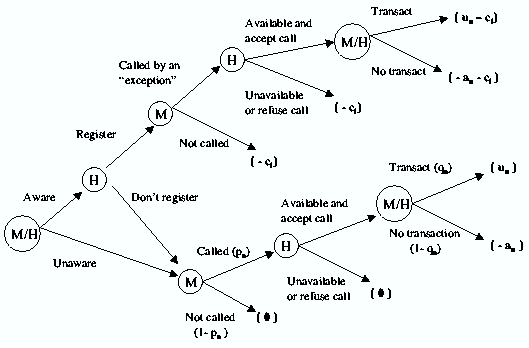
"The makers of our Constitution ... sought to protect Americans in their beliefs, their thoughts, their emotions and their sensations. They conferred as against the Government, the right to be let alone-the most comprehensive of the rights of man and the right most valued by civilized men."-U.S. Supreme Court Justice Louis D. Brandeis.

| (1) |
|
|
|
|
|
|
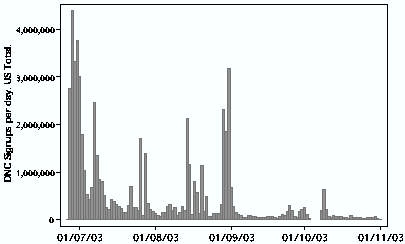
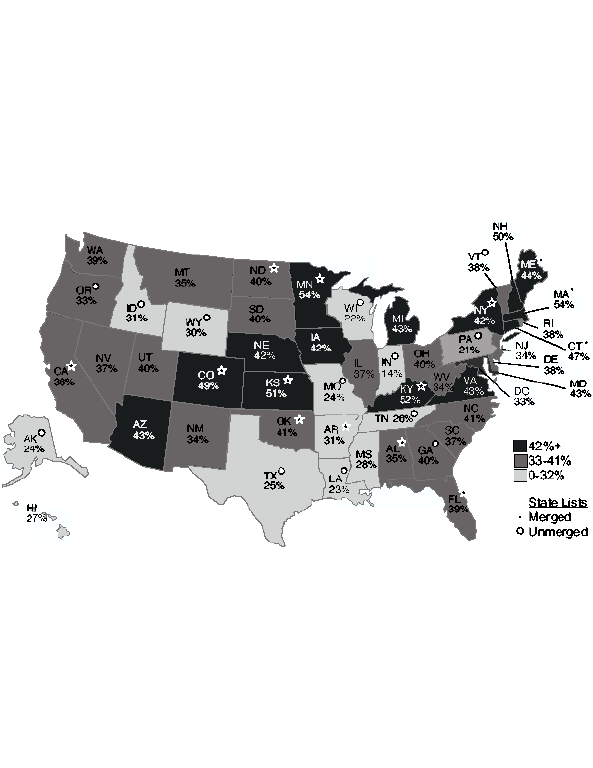
|
|
| Variable | Coefficient | Std. Err. | Mean | |
| pHHRace_White | 0.396 | ** | 0.004 | 0.870 |
| pHHRace_Black | 0.155 | ** | 0.019 | 0.077 |
| pHHRace_Native | -0.066 | 0.046 | 0.016 | |
| pHHRace_Asian | 2.688 | ** | 0.218 | 0.006 |
| pHHRace_PacIs | -14.072 | ** | 1.422 | 0.000 |
| pHHRace_Other | -0.499 | ** | 0.079 | 0.018 |
| pHHRace_Mult | 2.125 | ** | 0.353 | 0.011 |
| Significance levels : f : 10% * : 5% ** : 1% | ||||
| Variable | Coefficient | Std. Err. | Mean | |
| pRace_White | 0.151 | ** | 0.002 | 0.845 |
| pRace_Black | 0.053 | ** | 0.007 | 0.087 |
| pRace_Native | -0.055 | ** | 0.016 | 0.018 |
| pRace_Asian | 0.649 | ** | 0.068 | 0.008 |
| pRace_PacIs | -4.456 | ** | 0.431 | 0.001 |
| pRace_Oth | -0.215 | ** | 0.025 | 0.025 |
| pRace_Mult | 1.182 | ** | 0.116 | 0.015 |
| Significance levels : f : 10% * : 5% ** : 1% | ||||

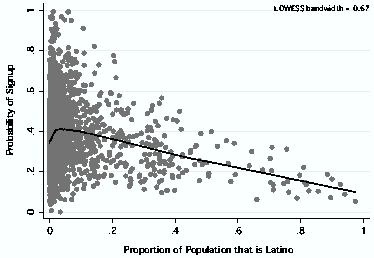
| Variable | Coefficient | Std. Err. | Mean | |
| pHHLatino | 0.169 | ** | 0.026 | 0.045 |
| pHHLatinoNo | 0.392 | ** | 0.003 | 0.955 |
| Difference | -0.223 | ** | F(1,3092)=66.28 | |
| Significance levels : f : 10% * : 5% ** : 1% | ||||
| Variable | Coefficient | Std. Err. | Mean | |
| pAgeHH15t24 | 0.559 | ** | 0.127 | 0.048 |
| pAgeHH25t34 | 0.080 | 0.135 | 0.145 | |
| pAgeHH35t44 | 0.554 | ** | 0.142 | 0.213 |
| pAgeHH45t54 | 1.146 | ** | 0.153 | 0.198 |
| pAgeHH55t64 | -0.444 | * | 0.198 | 0.147 |
| pAgeHH65t74 | -0.232 | 0.198 | 0.128 | |
| pAgeHH75up | 0.780 | ** | 0.114 | 0.121 |
| Significance levels : f : 10% * : 5% ** : 1% | ||||
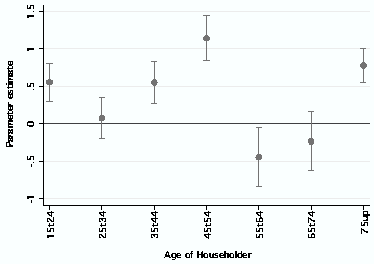
| Variable | Coefficient | Std. Err. | Mean | |
| pHHSize1 | 0.386 | ** | 0.072 | 0.253 |
| pHHSize2 | 0.753 | ** | 0.065 | 0.347 |
| pHHSize3 | -1.454 | ** | 0.157 | 0.162 |
| pHHSize4 | 3.285 | ** | 0.280 | 0.138 |
| pHHSize5up | -0.823 | ** | 0.096 | 0.238 |
| Significance levels : f : 10% * : 5% ** : 1% | ||||
| Variable | Coefficient | Std. Err. | Mean | |
| pKidsSub5 | 1.122 | ** | 0.204 | 0.147 |
| pKids5t11 | 0.126 | 0.175 | 0.244 | |
| pKids12t18 | 0.765 | ** | 0.119 | 0.220 |
| Significance levels : f : 10% * : 5% ** : 1% | ||||
| Variable | Coefficient | Std. Err. | Mean | |
| pHHInc_10dwn | -0.472 | ** | 0.093 | 0.121 |
| pHHInc_10t15 | 0.369 | 0.242 | 0.081 | |
| pHHInc_15t20 | 0.732 | ** | 0.249 | 0.078 |
| pHHInc_20t25 | 0.230 | 0.260 | 0.079 | |
| pHHInc_25t30 | 0.283 | 0.275 | 0.075 | |
| pHHInc_30t35 | 0.379 | 0.276 | 0.072 | |
| pHHInc_35t40 | 1.060 | ** | 0.299 | 0.065 |
| pHHInc_40t45 | -0.023 | 0.325 | 0.060 | |
| pHHInc_45t50 | 0.491 | 0.350 | 0.052 | |
| pHHInc_50t60 | 0.891 | ** | 0.251 | 0.088 |
| pHHInc_60t75 | 0.219 | 0.235 | 0.090 | |
| pHHInc_75t100 | -0.085 | 0.235 | 0.074 | |
| pHHInc_100up | 1.528 | ** | 0.109 | 0.066 |
| Significance levels : f : 10% * : 5% ** : 1% | ||||
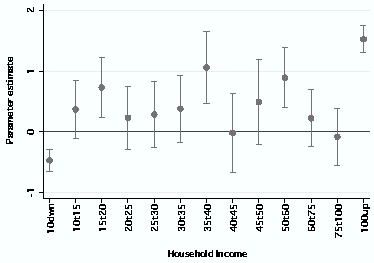
| Variable | Coefficient | Std. Err. | Mean | |
| pEduGrade | 0.087 | 0.057 | 0.091 | |
| pEduSomeHS | -0.191 | ** | 0.067 | 0.135 |
| pEduHS | 0.239 | ** | 0.031 | 0.348 |
| pEduSomeColl | 0.720 | ** | 0.046 | 0.262 |
| pEduColl | 0.414 | ** | 0.105 | 0.109 |
| pEduPostGrad | 1.506 | ** | 0.134 | 0.055 |
| Significance levels : f : 10% * : 5% ** : 1% | ||||
| Variable | Coefficient | Std. Err. | Mean | |
| pHHLingIso | -0.206 | * | 0.093 | 0.017 |
| pHHLingIsoNo | 0.392 | ** | 0.003 | 0.983 |
| Difference | -0.186 | ** | F(1,3092)=39.79 | |
| Significance levels : f : 10% * : 5% ** : 1% | ||||
| Variable | Coefficient | Std. Err. | Mean | |
| pHasMortgage | 0.576 | ** | 0.009 | 0.573 |
| pHasMortgageNo | 0.121 | ** | 0.012 | 0.427 |
| Difference | 0.455 | ** | F(1,3092)=483.83 | |
| Significance levels : f : 10% * : 5% ** : 1% | ||||
| Variable | Coefficient | Std. Err. | Mean | |
| pHHPoverty | -0.513 | ** | 0.036 | 0.142 |
| pHHPovertyNo | 0.530 | ** | 0.007 | 0.858 |
| Difference | -1.043 | ** | F(1,3092)=612.80 | |
| Significance levels : f : 10% * : 5% ** : 1% | ||||
| Variable | Coefficient | Std. Err. | Mean | |
| pUnmarriedPartners | 1.146 | ** | 0.186 | 0.043 |
| pUnmarriedNo | 0.348 | ** | 0.009 | 0.957 |
| Difference | 0.798 | ** | F(1,3092)=16.86 | |
| Significance levels : f : 10% * : 5% ** : 1% | ||||
| Variable | Coefficient | Std. Err. | Mean | |
| pNoMale | 0.216 | ** | 0.043 | 0.261 |
| pMale | 0.441 | ** | 0.015 7 | 0.739 |
| Difference | -0.225 | ** | F(1,3092)=15.07 | |
| Significance levels : f : 10% * : 5% ** : 1% | ||||
| Variable | Coefficient | Std. Err. | Mean | |
| pInternet | 0.431 | ** | 0.012 | 0.486 |
| pInternetNo | 0.335 | ** | 0.011 | 0.514 |
| Difference | 0.096 | ** | F(1,3092)=18.94 | |
| Significance levels : f : 10% * : 5% ** : 1% | ||||
| Variable | Coefficient | Std. Err. | Mean | |
| Urban | 0.466 | ** | 0.006 | 0.396 |
| Urban Area | 0.492 | ** | 0.008 | 0.164 |
| Urban Cluster | 0.427 | ** | 0.010 | 0.232 |
| Rural | 0.327 | ** | 0.005 | 0.604 |
| Farm | 0.611 | ** | 0.070 | 0.040 |
| Non-Farm | 0.315 | ** | 0.007 | 0.564 |
| Significance levels : f : 10% * : 5% ** : 1% | ||||
|
|
| (1) | (2) | (3) | (4) | (5) | (6) | (7) | (8) | |||||||||
| Kitchen Sink | Parsimonius I | Parsimonius II | State Level | |||||||||||||
| lHHInc_Med | 4.103 | ** | 2.634 | ** | 3.053 | ** | 2.772 | ** | 2.127 | ** | 2.028 | ** | ||||
| [0.621] | [0.378] | [0.147] | [0.139] | [0.088] | [0.091] | |||||||||||
| pHHPoverty | 6.619 | ** | 1.53 | |||||||||||||
| [4.040] | [0.809] | |||||||||||||||
| pInternet | 1.214 | * | 0.982 | |||||||||||||
| [0.119] | [0.087] | |||||||||||||||
| pHHRace: White | 1.997 | f | 8.451 | ** | ||||||||||||
| [0.765] | [3.028] | |||||||||||||||
| pHHRace: Black | 1.306 | 5.946 | ** | |||||||||||||
| [0.515] | [2.276] | |||||||||||||||
| pHHRace: Native | 1.025 | 3.681 | ** | |||||||||||||
| [0.548] | [1.824] | |||||||||||||||
| pHHRace: Asian | 0.255 | * | 2.969 | f | ||||||||||||
| [0.156] | [1.740] | |||||||||||||||
| pHHLatino | 1.793 | ** | 2.017 | ** | 3.300 | ** | 2.759 | ** | ||||||||
| [0.381] | [0.430] | [0.465] | [0.412] | |||||||||||||
| pHHSize2 | 19.439 | ** | 0.117 | ** | ||||||||||||
| [16.268] | [0.091] | |||||||||||||||
| pHHSize3 | 0.010 | ** | 0.001 | ** | ||||||||||||
| [0.012] | [0.001] | |||||||||||||||
| pHHSize4 | 0.018 | * | 0.002 | ** | ||||||||||||
| [0.030] | [0.004] | |||||||||||||||
| pHHSize5up | 149.270 | ** | 21.528 | ** | ||||||||||||
| [157.042] | [20.096] | |||||||||||||||
| pKidsSub5 | 12.596 | ** | 5.784 | * | ||||||||||||
| [11.353] | [4.535] | |||||||||||||||
| pKids5t11 | 0.097 | ** | 0.300 | f | ||||||||||||
| [0.080] | [0.214] | |||||||||||||||
| pKids12t18 | 0.011 | ** | 0.050 | ** | 0.078 | ** | 0.084 | ** | 0.198 | ** | 0.258 | ** | ||||
| [0.007] | [0.030] | [0.017] | [0.018] | [0.040] | [0.051] | |||||||||||
| pAgeHH25t34 | 3.225 | 0.072 | ** | |||||||||||||
| [3.117] | [0.061] | |||||||||||||||
| pAgeHH35t44 | 4.746 | f | 0.366 | |||||||||||||
| [4.363] | [0.290] | |||||||||||||||
| pAgeHH45t54 | 24.363 | ** | 1.234 | |||||||||||||
| [22.083] | [1.018] | |||||||||||||||
| pAgeHH55t64 | 2.908 | 1.849 | ||||||||||||||
| [3.279] | [1.787] | |||||||||||||||
| pAgeHH65t74 | 0.629 | 0.463 | ||||||||||||||
| [0.735] | [0.475] | |||||||||||||||
| pAgeHH75up | 0.557 | 0.623 | ||||||||||||||
| [0.474] | [0.466] | |||||||||||||||
| pHHLingIso | 0.020 | ** | 0.045 | ** | 0.006 | ** | 0.011 | ** | ||||||||
| [0.010] | [0.024] | [0.002] | [0.004] | |||||||||||||
| pNoMale | 2.452 | 0.157 | ** | |||||||||||||
| [1.628] | [0.094] | |||||||||||||||
| lHVal: Med | 0.852 | ** | 0.918 | * | ||||||||||||
| [0.034] | [0.036] | |||||||||||||||
| pHasMortgage | 1.237 | 2.540 | ** | |||||||||||||
| [0.258] | [0.532] | |||||||||||||||
| pEduLow | 0.208 | ** | 0.079 | ** | 0.091 | ** | 0.035 | ** | 0.007 | ** | 0.002 | ** | ||||
| [0.123] | [0.044] | [0.032] | [0.013] | [0.002] | [0.001] | |||||||||||
| pUnmarriedPartners | 0.013 | ** | 2.308 | |||||||||||||
| [0.013] | [2.601] | |||||||||||||||
| HasList | 0.533 | ** | 0.489 | ** | 0.546 | ** | 0.441 | ** | 0.554 | ** | 0.363 | ** | 0.492 | ** | 0.502 | ** |
| [0.011] | [0.089] | [0.010] | [0.080] | [0.011] | [0.068] | [0.012] | [0.124] | |||||||||
| MergeList | 2.391 | ** | 2.723 | ** | 2.287 | ** | 2.928 | ** | 2.148 | ** | 3.021 | ** | 2.254 | ** | 2.284 | ** |
| [0.054] | [0.431] | [0.045] | [0.463] | [0.042] | [0.490] | [0.055] | [0.500] | |||||||||
| pUrban: Area | 3.905 | * | 9.717 | ** | ||||||||||||
| [2.368] | [5.415] | |||||||||||||||
| pUrban: Cluster | 4.551 | * | 10.321 | ** | ||||||||||||
| [2.781] | [5.774] | |||||||||||||||
| pRural: Non-Farm | 3.904 | * | 8.418 | ** | ||||||||||||
| [2.464] | [4.896] | |||||||||||||||
| Observations | 3094 | 3094 | 3094 | 3094 | 3094 | 3094 | 3094 | 3094 | ||||||||
| Adjusted R2 | 0.61 | 0.75 | 0.58 | 0.72 | 0.55 | 0.70 | 0.28 | 0.45 | ||||||||
| Standard errors in brackets | ||||||||||||||||
| Significance levels : f : 10% * : 5% ** : 1% | ||||||||||||||||
| Model | Elasticity | Std. Err. | P > |z| | |
| (1) | Kitchen Sink | 0.880 | 0.094 | 0.000 |
| (2) | Kitchen Sink, SD | 0.604 | 0.089 | 0.000 |
| (3) | Parsimonius I | 0.694 | 0.031 | 0.000 |
| (4) | Parsimonius I, SD | 0.632 | 0.032 | 0.000 |
| (5) | Parsimonius II | 0.473 | 0.027 | 0.000 |
| (6) | Parsimonius II, SD | 0.441 | 0.028 | 0.000 |
| Elasticities Calculated at the Median Income: $35,348 | ||||
| Type | DK | NA | None | Small | Big | Very big |
| Telemarketing | 25 | 40 | 152 | 275 | 755 | 953 |
| Email spam | 2 | 847 | 86 | 205 | 509 | 661 |
| Telemarketing | ||||||
| Spam | DK | NA | None | Small | Big | Very big |
| DK | 1 | 0 | 0 | 0 | 1 | 0 |
| DNA | 22 | 28 | 87 | 98 | 259 | 353 |
| None | 0 | 1 | 23 | 13 | 17 | 32 |
| Small | 0 | 0 | 7 | 64 | 69 | 65 |
| Big | 1 | 6 | 12 | 64 | 257 | 169 |
| Very | 1 | 5 | 23 | 36 | 152 | 334 |
| (1) | (2) | (3) | (4) | |||||
| Week 1 | Week 2- | |||||||
| pInternet | 1.026 | 1.026 | 0.656 | ** | 0.617 | ** | ||
| [0.064] | [0.064] | [0.054] | [0.062] | |||||
| east | 1.345 | * | 0.793 | 1.424 | * | |||
| [0.175] | [0.114] | [0.231] | ||||||
| east*pInternet | 2.069 | ** | 1.215 | f | ||||
| [0.185] | [0.132] | |||||||
| Controls | yes | yes | yes | yes | ||||
| Observations | 3094 | 3094 | 3094 | 3094 | ||||
| Adjusted R2 | 0.79 | 0.79 | 0.79 | 0.80 | ||||
| Significance levels : f : 10% * : 5% ** : 1% | ||||||||
| Controls: | lHHInc_Med, pHHLatino, pKids12t18, | |||||||
| pHHLingIso, p_EduLow, HasList, | ||||||||
| MergeList and state dummies | ||||||||
| State | Start | Merged | DMA/TPS | Fee |
| Alabama | 6/29/00 | 20/8 | free | |
| Alaska | Nov'96 | $5-$50 | ||
| Arkansas | Jan'00 | 21/8 | $5/year | |
| California | 4/1/03 | 26/7 | free | |
| Colorado | 7/1/02 | 28/7 | free | |
| Connecticut | 1/1/01 | 22/8 | free | |
| Florida | Q2'99 | 9/8 | $10/$5 | |
| Georgia | Jan'99 | $5 | ||
| Idaho | Jan'01 | $10/$5 | ||
| Indiana | 1/1/02 | free | ||
| Kansas | 1/1/03 | 18/8 | free | |
| Kentucky | 7/15/02 | 17/8 | free | |
| Louisiana | 1/1/02 | free | ||
| Maine | 2003? | 26/7 | free | |
| Aug'01 | Yes | $$5 online | ||
| Massachusetts | 1/1/03 | 15/8 | free | |
| Minnesota | 1/1/03 | 20/8 | free | |
| Missouri | 7/1/01 | free | ||
| New York | 4/1/01 | 14/8 | free | |
| North Dakota | 4/1/03? | 9/8 | free | |
| Oklahoma | 1/1/03 | 22/7 | free | |
| Oregon | Jan'00 | $6.50/$3 | ||
| Pennsylvania | 4/2/02 | Yes | $5 online | |
| Tennessee | 7/1/00 | free | ||
| Texas | 1/1/02 | $2.25/number | ||
| Vermont | 7/1/02 | Yes | $5 online | |
| Wisconsin | 1/1/03 | free | ||
| Wyoming | Jul'01 | Yes | $5 online |
| Cost of Signing up | ||||
| Start Year | Free | Fee | TPS | Total |
| 2003 | 12.5% (7) | . | . | 12.5% (7) |
| 2002 | 33.6% (2) | . | . | 33.6% (2) |
| 2001 | 14.1% (1) | . | 7.2% (1) | 13.8% (2) |
| Earlier | 1.1% (1) | 1.0% (2) | . | 1.0% (3) |
| Total | 14.3% (11) | 1.0% (2) | 7.2% (1) | 11.8% (14) |
| Number of observations (states) in parenthesis. | ||||
| Wired | 92,695 | 72.1% |
| Wireless | 35,841 | 27.9% |
| Total | 128,536 | 100% |
| N | mean | sum | ||
| Wired | 3,185 | 15,123 | 48,165,480 | 82.4% |
| Wireless | 3,185 | 3,232 | 10,294,702 | 17.6% |
| Total | 3,185 | 18,355 | 58,460,182 | 100% |
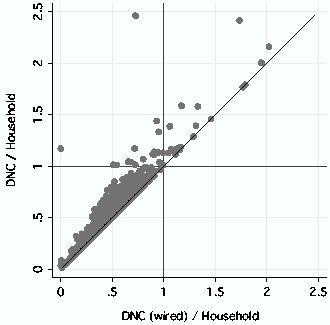
| # Lines | Frequency | Percent |
| 0 | 6,872 | 2.7% |
| 1 | 198,995 | 77.6% |
| 2 | 42,579 | 16.6% |
| 3 | 6,011 | 2.4% |
| 4 | 1,855 | 0.7% |
| Total | 256,312 | 100% |
| Mean | 1.241 | |
| Std. Dev. | 0.525 |
| Counties | |
| Total Counties | 3,200 |
| Cty Mean Used | 2,211 |
| Imputed | 989 |
| No State Mean | 72 |
| No County Mean | 102 |
| Diff > 0.02 | 815 |
|
|
|